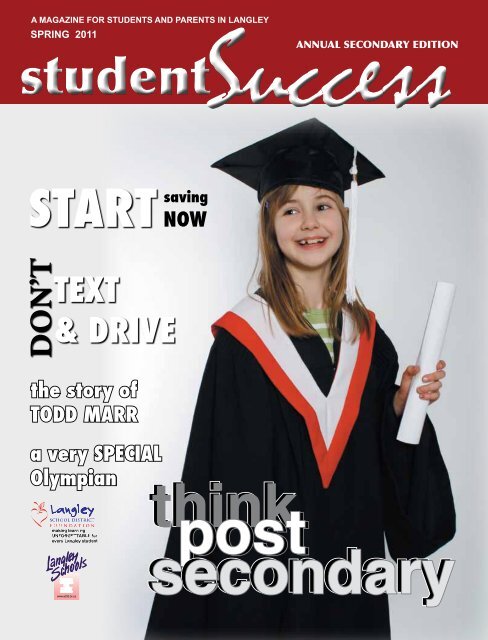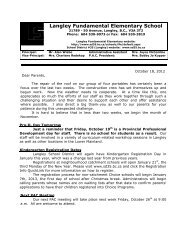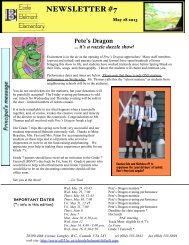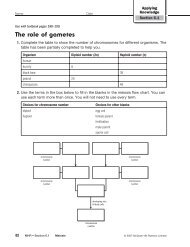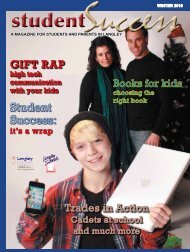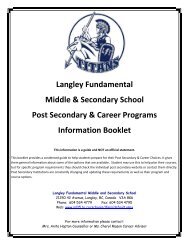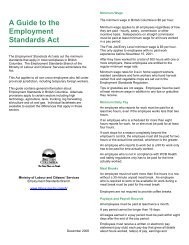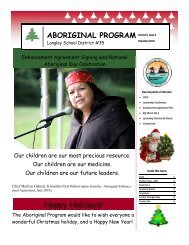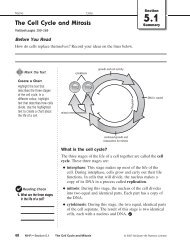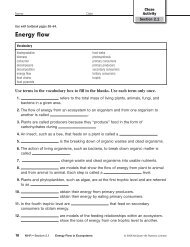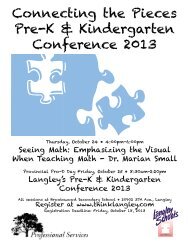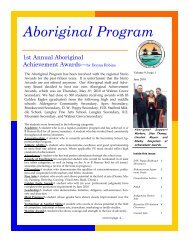Secondary Schools - School District #35
Secondary Schools - School District #35
Secondary Schools - School District #35
Create successful ePaper yourself
Turn your PDF publications into a flip-book with our unique Google optimized e-Paper software.
studentSuccess<br />
annual secondary edition<br />
A MAGAZINE FOR STUDENTS AND PARENTS IN LANGLEY<br />
spring 2011<br />
start saving<br />
now<br />
Don’t<br />
text<br />
& drive<br />
the story of<br />
Todd Marr<br />
a very SPECIAL<br />
Olympian<br />
think<br />
post<br />
secondary<br />
secondary edition 1
2 Student Success
Craig Spence<br />
Editor<br />
Susan Cairns<br />
Designer<br />
Andrew Sloan<br />
Advertising<br />
Success breeds Successes<br />
There’s so much going on in Langley <strong>School</strong> <strong>District</strong> of<br />
interest to families and students that we don’t always<br />
have room to fit it all into the print version of Student<br />
Success. And sometimes things come up between our Fall, Winter,<br />
Spring and Summer editions that we’d like to get to readers. And<br />
we also want to connect with secondary communities.<br />
So after just over a year in our current format, we’ve decided to<br />
launch a couple of initiatives we hope will improve our reach and<br />
the timeliness of the information we bring to you.<br />
First, I’d like to welcome you to visit the online version of Student<br />
Success at studentsuccessmagazine.blogspot.com. Going online<br />
opens up several new possibilities, which we’re really excited<br />
about. First, it allows us to post material whenever we like, and<br />
to have it available to readers 24 hours a day. All you have to do<br />
is bookmark the site.<br />
There’s more, though. In the blog we can provide you with live<br />
links to information related to the articles you read. That opens<br />
up whole new avenues of connectivity for parents and students,<br />
who can immediately follow up on information trails that might<br />
otherwise go cold. In an information age, where data passes by in<br />
a blink, that ability to click and go is essential.<br />
As well, the online version can be developed as a standing<br />
resource. If you go to the blog and look down the right column,<br />
you will come to a heading called ‘Labels’. Each article posted<br />
on the blog –just about every article that will appear in Student<br />
Success – will be labeled according to subject. So if, for instance,<br />
you want to find all the articles that have been posted related to<br />
Internet Safety, all you have to do is click on the label and up<br />
they’ll come. And if you can’t find a label, there’s also a search<br />
box you can try.<br />
Finally, the blog allows you to share information more readily.<br />
If you see something you like, you can email it, blog it, Twitter<br />
it, Facebook it and so on, all at the click of a button. Or, if you<br />
want to reach us with comments or ideas, there’s a direct email<br />
link posted on the blog’s home page.<br />
There are more features to the Success blog, but we’re going to<br />
have to let you discover them yourself because we want to leave<br />
a little room to talk about our Student Success <strong>Secondary</strong> edition.<br />
This targeted publication, which some of you are reading right<br />
now, having discovered it in your child’s report card envelop,<br />
will carry information about planning for post-secondary, events<br />
and activities going on in secondary venues, choices available to<br />
secondary students and issues secondary students and parents<br />
need to be aware of. Issue Number One is a pilot. Based on the<br />
feedback we get, we will determine the look, format and content<br />
of Issue Number Two. So let us know what you think.<br />
studentSuccess<br />
Student Success is published and<br />
produced by the Langley <strong>School</strong><br />
<strong>District</strong> in partnership with<br />
the Langley <strong>School</strong><br />
<strong>District</strong> Foundation.<br />
EDITOR<br />
Craig Spence<br />
cspence@sd35.bc.ca<br />
604-534-7891<br />
Designer<br />
Susan Cairns<br />
scairns@sd35.bc.ca<br />
604-534-7891<br />
Advertising sales<br />
Andrew Sloan<br />
Sloan & Co.<br />
604-889-6397<br />
andrew@sloanandco.ca<br />
Advertising Traffic<br />
Denise Begg<br />
604-534-7891<br />
dbegg@sd35.bc.ca<br />
Illustrations<br />
Raymond Brown<br />
<strong>Secondary</strong> Student<br />
Success is published<br />
once a year with a<br />
press run of 10,000.<br />
Student Success is distributed<br />
to school district families,<br />
businesses, associations<br />
and municipal offices<br />
throughout Langley.<br />
© sd35(Langley)<br />
4875-222nd Street<br />
Langley, BC<br />
V3A 3Z7<br />
secondary edition 3
GUEST PASS<br />
1 Month Unlimited<br />
studentSuccess<br />
volume 1 number 1 secondary 2011<br />
Features<br />
5 The todd marr story<br />
family donates $20,000 to drug prevention program<br />
6 Restorative Action<br />
it takes time but it’s worth it<br />
8 Life-long learning<br />
the kids will eventually figure it out<br />
Pacific Coast Taekwondo & Hapkido<br />
“Serving Langley Since 1988"<br />
604.533.7855 / 604.818.7859<br />
www.taekwondo.bc.ca<br />
Langley’s International<br />
Festival Society<br />
p o e m<br />
story<br />
Creative Writing<br />
Competition<br />
“Living in a Multicultural Society”<br />
Write approximately 250 words about your experience<br />
of living in a multicultural society.<br />
(Story, Poem, Letter, Essay, Rap or Lyrics)<br />
10 beyond the classroom<br />
start saving that RESP now<br />
12 Don’t text and drive<br />
the most important message you’ll receive<br />
13 A very special olympian<br />
Matthew Williams has the spirit<br />
Win Big CASH!!!!<br />
First Prize: $1000<br />
Second Prize: $750<br />
Third Prize: $500<br />
report<br />
narrative<br />
... and get published!!<br />
essay<br />
Get your entry form from www.internationalfestival.ca<br />
and email your entry or questions to doris@bravointeriors.ca<br />
or print, complete and fax your entry form to: 604-514-2294<br />
Front cover shot:<br />
Photographer: Cameron Goldie<br />
Lighting Assistant: Ashley Ford<br />
Model: Annika McCrae<br />
All are students from Langley Fine Arts<br />
Phone: 604-312-8487 | Fax: 604-514-2294 | info@internationalfestival.ca | www.internationalfestival.ca<br />
PO Box 7, 20378 Fraser Hwy., Langley, BC V3A 4G1<br />
4 Student Success<br />
G r a p h i c D e s i g n : L I G H T H O U S E D E S I G N | w w w . l i g h t h o u s e d e s i g n . c a | 6 0 4 . 5 0 2 . 9 7 7 1
foundation<br />
Project Resiliency<br />
Family donates $20,000 to drug<br />
prevention program<br />
When Lorraine Marr<br />
happened upon three<br />
boys smoking marijuana<br />
in an alley, her first thought was to<br />
turn the other way. But then she<br />
reconsidered and approached the<br />
teens. She was met with hostile,<br />
defiant glares. One boy stomped off.<br />
“I’m not here to admonish you,” she<br />
said. “But do you mind if I tell you<br />
a story.”<br />
The boys rolled their eyes, but<br />
Lorraine persevered. When she<br />
finished, the two were truly shaken.<br />
Here is her story. It’s about a popular,<br />
smart, athletic boy. Lorraine’s son,<br />
Todd.<br />
Todd was one of those kids that<br />
everybody liked. Although he was<br />
an honors student and a star athlete<br />
in school, he had a charming, selfeffacing<br />
manner and a large and<br />
diverse group of friends. He was<br />
every parents dream. Until the day<br />
he started experimenting with drugs.<br />
Like most he dabbled in soft drugs,<br />
but before long he was hooked,<br />
seriously hooked, on crystal meth.<br />
So began his long journey through<br />
hell.<br />
He managed to graduate from<br />
school, but university plans were put<br />
forever on hold. His parents were<br />
puzzled, but not overly concerned.<br />
They had no idea that their beautiful<br />
boy was addicted to drugs. He kept<br />
Smart, athletic and<br />
popular - Todd Marr<br />
desperately fought<br />
for his life and lost<br />
it to himself and most people were<br />
fooled. But the struggle took its toll.<br />
Several years went by and the drug<br />
continued to hold Todd in its<br />
fearful grip. He was becoming more<br />
and more desperate. He started to<br />
look for help. There was none to<br />
be found. Finally, he sought out his<br />
family. They were devastated, but<br />
they stood by him. They joined<br />
him in his search for a clinic, a cure,<br />
therapy – anything that would help<br />
their boy. There was nothing. Todd<br />
even tried to check himself into the<br />
hospital, but they wouldn’t take him.<br />
He lost hope and crippling despair<br />
set in.<br />
Two days later, he committed suicide.<br />
He left behind his mother Lorraine,<br />
father Chuck, sister Lana and<br />
brother Dean. Now the Marr family<br />
is fighting to save other kids from the<br />
evil, insidious drug, known as crystal<br />
meth. They investigated programs<br />
throughout British Columbia. They<br />
interviewed doctors, counselors<br />
and therapists. Then they looked<br />
within their own community and<br />
found the Langley <strong>School</strong> <strong>District</strong>’s<br />
James Anderson Learning Centre<br />
offering Project Resiliency – a drug<br />
awareness and prevention program<br />
for students and parents.<br />
Under the capable direction of the<br />
principal, Dr. Patrick Thomas and<br />
counselor, Dee Bassi, the school<br />
takes in at-risk students from<br />
throughout the district and works<br />
with them on their drug use and<br />
addiction. The results have been<br />
amazing.<br />
The Marrs concur.<br />
“We only wish that the program<br />
was available when Todd was going<br />
through school,” said Todd’s father.<br />
The family has donated $20,000 to<br />
the program. “Hopefully, this will<br />
help other kids like Todd,” said<br />
Lorraine. v<br />
secondary edition 5
feature<br />
Peacebuilding<br />
TAlking<br />
peace<br />
conversation<br />
peace<br />
Restorative Action in<br />
Elementary <strong><strong>School</strong>s</strong><br />
Restorative Action in <strong>Secondary</strong> <strong><strong>School</strong>s</strong><br />
Fraser Region Community Justice Initiatives Association & Langley <strong>School</strong> <strong>District</strong> <strong>#35</strong><br />
TRAINER MANUAL<br />
Fraser Region Community Justice Initiatives Association & Langley <strong>School</strong> <strong>District</strong> <strong>#35</strong> • www.sd35.bc.ca<br />
Restorative Action<br />
it takes time but it’s worth it<br />
As BC’s Restorative Justice Coordinator, and a seminal figure in the implementation<br />
of Restorative Action programs in Langley <strong>School</strong> <strong>District</strong>,<br />
Catherine Bargen knows in her heart that it makes absolute sense<br />
to heal relationships rather than simply punish transgressors when ‘harm’ has<br />
been done in a community.<br />
That’s the foundational principle of Restorative Justice.<br />
But ask her if she still has to struggle with the impulse to punish and Ms. Bargen<br />
doesn’t hesitiate. “Absolutely,” she said. “I’m constantly uncovering, and<br />
uncovering, and uncovering more and more layers of how deep it goes within<br />
us – the impulse to cut people off instead of staying in a relationship with<br />
them when we are experiencing conflict.”<br />
Catherine Bargen, author of<br />
Educating for Peacebuilding<br />
the new Restorative Action<br />
resource<br />
She and her colleagues don’t have any illusions about how much work remains<br />
to be done to shift society’s deeply ingrained response from punishment to<br />
a philosophy of healing. But there are examples of progress, Langley <strong>School</strong><br />
<strong>District</strong> being one of them.<br />
Ms. Bargen recently launched her new book Educating for Peacebuilding,<br />
which is based to a large degree on the successful implementation of Restorative<br />
Action programs in this district. What distinguishes Langley from most<br />
others is the fact that Restorative Justice was adopted as a district-wide strategy<br />
Ms. Bargen noted.<br />
Restorative Action is part of the curriculum at the elementary and secondary<br />
levels in Langley, with Talking Peace introducing younger students to the principles<br />
of Restorative Action, and Conversation Peace building on that learning.<br />
“Conversation Peace is a training manual outlining four days of training and<br />
6 Student Success
a student workbook,” Ms. Bargen said. “It really is just<br />
teaching the skills of mediation and the principles embedded<br />
in that mediation.”<br />
Restorative Action Coordinator for Langley <strong>School</strong> <strong>District</strong><br />
Dan Basham said ‘teams’ have been established in<br />
seven Langley high schools. This fall 50 secondary students<br />
were trained using the Conversation Peace manual,<br />
and training was also offered to 24 elementary students.<br />
He noted that as well as getting support from the district<br />
the program is getting support from the community.<br />
Coast Capital Savings has provided funding.<br />
Despite Langley’s progress, he said there’s a long way to<br />
go. “Punishment is very quick,” he said. “I’m not saying<br />
everybody deals with things in a punitive way, but it may<br />
not be being dealt with in a restorative way either, right,<br />
because that takes time to do properly.”<br />
Lasting solutions almost always take time though, and<br />
Mr. Basham believes we won’t ever get there if we run out<br />
of patience. “If you just jump to solutions, which is the<br />
tendency because as adults we want to fix things for kids,<br />
then it’s very difficult to come to a meaningful kind of<br />
solution or agreement or consensus,” he said.<br />
Mr. Basham doesn’t rest his case for Restorative Action<br />
on a strictly cost-benefit analysis. A system that embraces<br />
mediation instead of punishment might see a decrease<br />
in anti-social behaviours; it will certainly feel empowered<br />
when it comes to dealing with situations that will inevitably<br />
occur.<br />
“I think there would still be conflict – I mean conflict is<br />
normal,” he explained. “What would change is students’<br />
ability to resolve conflict in a peaceful way. Students<br />
would be more equipped with tools to resolve things next<br />
time in a better way.”<br />
Makes sense. So why isn’t Restorative Justice the norm<br />
“I think one of the systemic obstacles is our deeply held<br />
views around punishment,” Ms. Bargen said. “Even those<br />
of us who think it does make sense, we do find ourselves<br />
wanting revenge or thinking that people do need to be<br />
punished for their wrong actions.<br />
“That’s almost reflexive in our society. Our notions about<br />
punishment are very deeply held. “<br />
Madeleine de Little, Senior Counselor at Langley Fine<br />
Arts <strong>School</strong>, believes that reflex can be countered by a determined<br />
effort to implement Restorative Action. LFAS<br />
Madeleine de Little, Senior<br />
Counselor at Langley<br />
Fine Arts <strong>School</strong><br />
Dan Basham, Coordinator<br />
Restorative Action for Langley<br />
<strong>School</strong> <strong>District</strong><br />
has a very active program, she noted. Up to 30 students<br />
often show up for weekly Restorative Action breakfast<br />
meetings, and the school’s annual RA retreat has been a<br />
huge success.<br />
She said the program changes students who participate in<br />
it. At one of their weekly sessions the students were asked:<br />
“How is it impacting your life now”<br />
“They were saying ‘I’m different,” Ms. De Little reported.<br />
“I’m completely different because of my experiences and<br />
what I’ve been learning over the last few years. I’m more<br />
understanding; I’m more compassionate. I see the world<br />
differently. I view conflict differently.”<br />
“It’s just unbelievably important that every child learn this<br />
stuff,” she concluded.<br />
Critics argue that you can’t make someone engage in a<br />
restorative process in good faith. Ms. Bargen responds<br />
that a variety of responses are necessary, but that the effort<br />
should be made to restore relationships rather than<br />
punish offences.<br />
“If the person who has caused harm isn’t willing to engage,<br />
then we start saying ‘Well, we’d like to support you<br />
in doing better or making things right,’ but when that<br />
doesn’t happen we as a community say, ‘We’re not okay<br />
with what you’re doing,’ and boundaries need to be put<br />
in place.”<br />
The objective, though, is to enlarge those boundaries if<br />
possible, so that those who have caused harm can learn to<br />
take responsibility for their actions. v<br />
secondary edition 7
feature<br />
Planning for post-secondary<br />
Life-long learning<br />
isn’t always easy<br />
Asked if parents should be concerned<br />
if no clear career choice has<br />
materialized, even after students<br />
have left the secondary fold, Ms.<br />
Rosen answered, “not overly.”<br />
“A lot of the literature tells us that a<br />
person can take up to 10 years to<br />
actually end up where they’re going<br />
to end up when it comes to occupations<br />
and so on. So I think the<br />
simple answer to your question is,<br />
there’s no need for concern, everybody<br />
will find their way.”<br />
“Even if your kids don’t seem like they<br />
are planning for a successful future,<br />
they will often fool you. Eventually<br />
most of them figure it out.”<br />
Pat Rosen, Langley <strong>District</strong> Teacher-<br />
Career Education<br />
8 Student Success<br />
What is your child going to<br />
be doing that first Tuesday<br />
after Labour Day, after<br />
he or she has graduated from high<br />
school Every year thousands of<br />
students throughout BC are either<br />
thinking hard about that question,<br />
avoiding it, or have already got an<br />
answer and are living it.<br />
And every year, thousands of parents<br />
are pacing the sidelines wondering if<br />
their kid is making the choices that<br />
will move the yardsticks in the right<br />
direction.<br />
But Career Education Teacher Pat<br />
Rosen suggests it’s a mistake to think<br />
about the future as a grid of right<br />
and wrong choices. A more positive<br />
and realistic view is of young adults<br />
being open to a range of possibilities,<br />
and focusing on the skills they want<br />
to build on.<br />
But she knows the simple answer<br />
doesn’t always cut it when children’s<br />
futures are at stake. Young grads and<br />
parents want to know, even in their<br />
moments of deepest doubt, that success<br />
isn’t slipping out of reach, and<br />
that when the time comes the lessons<br />
learned during 13 years of schooling<br />
and 18 years of living will gain some<br />
traction in the ‘real world’.<br />
Ms. Rosen maps out two very distinct<br />
skill sets people acquire as they<br />
move into the working world. There<br />
are specific skills university students<br />
and apprentices learn through education<br />
and training; then there’s<br />
a whole set of more general skills<br />
about how to succeed at a career,<br />
things like: knowing what kinds<br />
of occupations are out there; what<br />
education and training programs<br />
are available; how to apply to postsecondary<br />
programs; how to finance<br />
post-secondary options.<br />
Pretty well at the top of the life skills<br />
list is one that’s embedded in the<br />
Graduate Profile of Langley <strong>School</strong><br />
<strong>District</strong>, and is a key component of<br />
the Planning 10 and Grad Transition<br />
programs: Life-Long Learning.<br />
Get that right and the future will<br />
likely fall into place.
Entering our 36 th Year<br />
72 percent of occupations require some form<br />
of formalized post-secondary training after high school<br />
Girls and Boys 5 & up<br />
Make new friends<br />
Have fun and exercise<br />
Be part of a team<br />
Stay fit or<br />
Earn great money<br />
as an umpire<br />
Register Now!*<br />
“The learning outcomes within those courses and programs<br />
asks young people to basically follow a career development<br />
cycle, to look at themselves in all of their areas<br />
of strengths and some of their areas of challenge, and to<br />
say, ‘Where could I go in terms of what I have to offer<br />
and what I’m interested in’<br />
“What we know is 72 percent of occupations require some<br />
form of formalized post-secondary training after high<br />
school,” Ms. Rosen observed. “Formalized education after<br />
high school is in the cards for most people.”<br />
That doesn’t mean everyone is going to pack his bags and<br />
head straight off for university, or college, or apprenticeship.<br />
Some may choose to travel, or work for a while, or<br />
hole up in their rooms. Nervous as it makes them when<br />
their kids don’t follow a set trajectory, parents have to<br />
know it’s usually okay. Kids will figure things out.<br />
“There’s really no one-way to do this, there’s no ‘right’ way<br />
to do this, and you can’t really go wrong either. We from<br />
a career-education perspective don’t even like to think of<br />
a misstep per se. Everything informs us in terms of who<br />
we are and where we might go, and where we might fit<br />
for down the road.”<br />
Much as parents want to nudge their kids in the right directions,<br />
their role has changed. “They’re going to be the<br />
coach on the sidelines,” Ms. Rosen said. “They’re going to<br />
be the encourager.”<br />
“The older the child gets, the less likely parents are to be<br />
making the decisions, because these are life skill areas that<br />
young people in fact own, and they make all the choices<br />
in order for things to come to be.”<br />
Perhaps a tough lesson, but like their kids parents will get<br />
through it. v<br />
*RobinMclean@telus.net Ken Maher: 604-220-7474<br />
www.LangleyFastball.com<br />
Tuition-Free Program*<br />
Career Choices and Life Success<br />
Your kids are<br />
in school, what<br />
about you<br />
kwantlen.ca/aca/ccls<br />
Prospective students require an<br />
interview before registering.<br />
Contact Elly Morgan at<br />
604.599.3431 or email<br />
elly.morgan@kwantlen.ca<br />
For women who want<br />
to find meaningful<br />
work and more<br />
• Take the time to try out various careers before<br />
you invest time and money<br />
• Spend time with employers on work<br />
placements to gain recent work experience<br />
• Participate in vocational assessments to assist<br />
you in choosing a career<br />
• Upgrade your computer skills including<br />
MS Office and PowerPoint<br />
• Update your resumé and interview skills<br />
• Focus on what you want, and learn how to go<br />
for it<br />
• Move forward beyond procrastination and fear<br />
• Communicate to improve your relationships<br />
• Gain confidence to deal with conflict<br />
September-December 2011 Program<br />
Attend One Information Session<br />
All information sessions are held in<br />
Room 2075 at the Langley Campus<br />
May 6, June 9, August 25<br />
* Admission, registration and Student Association fees apply<br />
secondary edition 9
feature<br />
Financial Planning<br />
Beyond the<br />
Classroom<br />
Start that RESP now if you want to get the most<br />
out of it<br />
There are gifts that come with ribbons and gifts<br />
that come with strings. RESPs come with a little<br />
of both. But Avi Kay, a Certified Financial Planner<br />
with Envision Financial Credit Union, said it’s a program<br />
well worth looking into for families planning their<br />
children’s post secondary futures.<br />
“As a new parent myself, I strongly believe that the pros<br />
outweigh the cons,” he said.<br />
On the upside, a Registered Education Saving Plan will<br />
attract matching contributions of 20% from the Government<br />
of Canada. You can deposit up to $2,500 per year<br />
per child in a RESP and the government will kick in up to<br />
$500 per year until your child reaches age 17.<br />
If you do not maximize your annual contributions, the<br />
remaining contributions that would have been matched<br />
do carry forward to future years, although the maximum<br />
government grant paid in any calendar year will not exceed<br />
$1,000.<br />
The lifetime contribution limit is $50,000 per child and<br />
the maximum the government grants can add up to is<br />
$7,200. There are additional generous government grants<br />
depending on one’s household income.<br />
And there’s an upside to RESPs beyond the grant money.<br />
Mr. Kay noted that RESPs are tax-sheltered investments,<br />
which means any investment income earned on your deposited<br />
funds comes tax-free and will compound over<br />
the life of your RESP. As well, they are essentially ‘shell<br />
accounts’, which means that the money you put into a<br />
RESP can be invested in different ways to maximize the<br />
investment income earned.<br />
What’s ahead for<br />
your child after<br />
graduation<br />
from school.<br />
Are you prepared<br />
Illustration by Raymond Brown<br />
To maximize the benefit of an<br />
RESP, you have to get in early<br />
So why isn’t every family rushing out to open a RESP the<br />
moment their child is born Mr. Kay figures less than half<br />
of Canadian families take advantage of the free money<br />
and sheltered investment earnings that come with RESPs.<br />
The biggest constraint, he suggested, is “cash-flow”.<br />
To take full advantage of the program, you have to come<br />
up with $2,500 per year per child. That works out to<br />
$208.33 per month or $96.15 bi-weekly until your child<br />
reaches 17 years old, after which matching grants are<br />
no longer available. For many families that just can’t be<br />
squeezed out of their budgets, especially since the child<br />
rearing years are often when families are most financially<br />
stretched.<br />
As well, some are turned off by the seemingly complicated<br />
rules and requirements of registering an education<br />
savings plan, and potentially tying up a significant investment<br />
over a long period of time. Then there’s the question<br />
of what to do if your child doesn’t continue on to postsecondary<br />
school<br />
Bottom line, you will always get back what you put in.<br />
But if the RESP funds are not used for educational purposes,<br />
the federal government will take back its contributions.<br />
Taxes will also apply to the investment earnings<br />
that were sheltered by the fund, although there are ways<br />
of mitigating that impact by transferring the earnings into<br />
Registered Retirement Savings Plans, if you have room.<br />
10 Student Success
Like any investment RESPs may entail a certain amount<br />
of risk. But this risk is being taken to help cover the costs<br />
of post-secondary education for families. Mr. Kay points<br />
out that with escalating student costs, and the average<br />
post-secondary student now graduating with an average<br />
of $18,000 in education-related debt according to the Vanier<br />
Institute, a long-term plan is an option that makes<br />
sense for many families.<br />
To maximize the benefit you have to get in early, he advised.<br />
“If possible, you certainly want to maximize the<br />
amount the government will match in the form of a<br />
grant.”<br />
Figures Mr. Kay pulled up from a university cost calculator<br />
showed that a student in an arts program at a publicly<br />
funded university can expect to pay about $19,500 in tuition<br />
and fees over four years. If you add an accommodation<br />
plan to that, university costs jump to $37,500. Then<br />
you can add on books, transportation and other living<br />
expenses.<br />
A similar calculation for an engineering student at another<br />
university results in $25,650 for tuition and fees<br />
and a total cost of $46,000. A calculation for a private<br />
university rings in at about $80,000. And those costs are<br />
not likely to go down. If anything, post-secondary education<br />
costs are likely to increase.<br />
An important question to ask is: What kinds of post-secondary<br />
education programs can be paid for using RESP<br />
funds You can find out on the CanLearn web site at www.<br />
canlearn.ca. There’s all kinds of information on the site to<br />
help families and students prepare for post-secondary. It’s<br />
well worth a visit.<br />
You can also find a lot of info online at www.envisionfinancial.ca.<br />
Just click RESP into the search box on the<br />
site then select Education Planning (RESPs), which will<br />
be at the top of the search list. Be sure to have a look at<br />
the RESP brochure, which can be downloaded in PDF<br />
format.<br />
Families are coming up with innovative ways to keep up<br />
with RESP contributions. For instance, instead of adding<br />
to the pile of toys and gadgets under the Christmas tree,<br />
some grandparents are contributing to their grandkids’<br />
RESPs. Maybe not exactly what Junior would like to see<br />
wrapped with ribbons and a bow, but it does offer opportunities<br />
for families to talk post-secondary. v<br />
Register Now<br />
Neuro-behavioral Teaching Services:<br />
Integrating educational and psychological expertise to assist students with complex learning needs<br />
We serve clients from age 9 through adulthood with neurologically-based disorders such as:<br />
· Autism Spectrum Disorders<br />
· Brain Injury<br />
· Fetal Alcohol Spectrum Disorders<br />
who are having difficulty maintaining an appropriate grade level performance.<br />
Equipped for Learning Inc. is a supplemental education<br />
centre designed to develop Executive Functions (e.g.<br />
problem solving, decision making, self-evaluation etc.)<br />
within the context of developing learning/study skills,<br />
composition/essay skills and numeracy skills.<br />
For more information call Susan Hegler,<br />
our Education Director, at 604-581-0508<br />
or visit www.equippedforlearning.com<br />
#204 - 14888 104 th Avenue, Surrey BC<br />
secondary edition 11
safety<br />
Technology<br />
Don’t text and<br />
drive...get the message<br />
Here’s a simple exercise that might just save your life, or a<br />
friend’s, or your child’s.<br />
Look down at your right hand, curl it as<br />
if you’re holding something compact that<br />
your fingers fit round snuggly, now count<br />
to three slowly. One-thousand-and-one,<br />
one-thousand-and-two, one-thousand-andthree…<br />
now snap your fingers.<br />
Brad Gorski<br />
was told he would<br />
never walk again<br />
Now imagine what you’re looking at as you<br />
count those seconds is a cell phone, and your<br />
texting a friend. No big deal, just the normal<br />
kind of yak that jiggles the airwaves all the<br />
time: a laugh about last night’s party, or a<br />
reminder about this morning’s meeting.<br />
The three seconds is how long it might take<br />
you to run a red light smack into the path of<br />
an oncoming semi; the snap of your fingers<br />
is how long it would take that semi to plow<br />
into your car, cave in the driver’s side doors,<br />
throw you into the steering column, collapse<br />
a lung and cause a Traumatic Brain Injury –<br />
TMI.<br />
That’s what happened to Brad Gorski on<br />
October 30, 2005, when, as he was heading<br />
for the gym and a morning workout, he<br />
decided to text and drive. After his accident<br />
he was in a coma for seven weeks. He awoke<br />
to a grim prognosis. Doctors told him he<br />
would not likely walk or drive again. But one<br />
thing hadn’t changed – Brad’s determination<br />
to live life to the fullest.<br />
Refusing to accept any limitations he<br />
set to work on his recovery, first at Royal<br />
Columbian Hospital, then at G.F. Strong<br />
Rehabilitation Centre. He is able to walk<br />
now, and drive, and talk, and eat and a<br />
thousand other things he once took for<br />
granted. Having had to earn those abilities<br />
back, Brad has a message those who text and<br />
drive – or ‘multi-task’ and drive in any way:<br />
DON’T DO IT!<br />
“Do you really want to put your family, your<br />
friends, yourself through what I’ve been<br />
through” he asks. “It’s not worth it.”<br />
Brad has a lineup of schools eager to have him<br />
do his presentation on the hazards of using<br />
cell phones while driving. Since appearing<br />
on TV the requests have been rolling in. But<br />
he wants more schools to invite him.<br />
“I speak on my life pre-accident, the crash<br />
itself, what it did to me and everyone around<br />
me and how stupid it is to use cell phones<br />
while driving,” he says in a letter to schools.<br />
“I’m living proof on what can happen when<br />
you are not paying attention while driving.”<br />
It’s a message teens need to hear. Laws<br />
against using cell phones while driving have<br />
been enacted. But stand at any intersection<br />
for a few minutes and there’s a good chance<br />
you’ll see people driving while talking or<br />
even texting. Brad wants to push the end-call<br />
button on those kinds of risky habits.<br />
He thinks he’s making a difference.<br />
Recently he received a call about the effect<br />
his presentation had on one young man.<br />
“Because he saw me and what I went through<br />
and my life, he will never text and drive.”<br />
That’s the kind of impact Brad wants to have<br />
on the young people he’s talking to. Contact<br />
Brad at bgorski35@hotmail.com. v<br />
12 Student Success
sports<br />
Olympics<br />
Matthew Williams in training<br />
to compete in the Special Olympics<br />
Olympian<br />
a very special<br />
What’s so special about the Special Olympics Just ask Matthew<br />
Williams.<br />
Matthew, a recent Walnut Grove<br />
<strong>Secondary</strong> grad is a Global<br />
Congress Chair, sitting on the<br />
Board of the Special Olympics Committee.<br />
He’s a Global Messenger for the Special<br />
Olympics. And he’s a very special Olympian<br />
himself.<br />
That’s a lot of accomplishments, but<br />
Williams has a few of more points he can put<br />
on his resume. He’s got an infectious, upbeat<br />
attitude. He trains rigorously, exhibiting the<br />
discipline that makes a great athlete. And he<br />
celebrates the achievements of everyone on<br />
the field as much as his own – his world is<br />
full of winners.<br />
Williams knows sports from the ground up,<br />
and there doesn’t seem to be a sport he’s not<br />
enthusiastic about. He participates yearround<br />
in six or seven events including speed<br />
skating, curling and basketball in the winter;<br />
soccer, track and field and softball in the<br />
summer.<br />
He explained that taking to the ice or the<br />
playing field is like stepping into a world<br />
where he is meant to be. “It feels sort of like<br />
I’m free. I let go of everything else that’s on<br />
my mind – I’m there,” he said. “I’m free to<br />
be myself.”<br />
That’s something Special Olympians share<br />
with all athletes. “I have a passion for my<br />
sports,” he said. “A lot of athletes that don’t<br />
have disabilities say they have a passion for<br />
their sport, that they love it, and it’s where<br />
they can be themselves and forget about<br />
everything else.<br />
“I feel the same, so we’re not very different. It<br />
doesn’t matter if you have a disability or you<br />
don’t, you’re an athlete.”<br />
That’s one of the messages Williams wants to<br />
get out in his role as official Messenger for<br />
the Special Olympics. People are familiar<br />
with the Olympics and Paralympics, he said,<br />
but many don’t know about the thousands<br />
of athletes who participate in the Special<br />
Olympics worldwide.<br />
The Special Olympics are for athletes that<br />
have intellectual disabilities. Williams is<br />
secondary edition 13
BRAD HIGGS<br />
SOCCER SCHOOLS<br />
Serving British Columbia Since 1977<br />
SOCCER CAMPS:<br />
Days: Mon-Fri<br />
Age: Boys & Girls 4-14 years old<br />
Cost: $100<br />
LANGLEY<br />
• July 11-15 McLeod Turf (9:00-11:30)<br />
• Aug 29-Sept 1 (M-Wed 9:00-12:30,<br />
Thurs 9:00 - 11:00)<br />
SURREY<br />
• July 18-22 (9:00 - 11:30)<br />
Newton Athletic Park<br />
• Aug 22-26 (9:00 - 11:30)<br />
Cloverdale Athletic Park<br />
• Aug 29-Sept 2 (9:00 - 11:30)<br />
Bear Creek Park<br />
WHITE ROCK<br />
• July 4-8, July 25-29 and Aug 22-26<br />
Centennial Park 9:00 - 11:30<br />
p<br />
TO REGISTER:<br />
online: www.bradhiggs.com<br />
or phone: 604-939-1114<br />
by mail: mail cheque to Brad Higgs<br />
116 Maple Dr. Port Moody BC, V3H 0A7<br />
5711 Production Wy<br />
PO Box 3519<br />
Langley, BC<br />
V3A 4R9<br />
epileptic. Fellow Special Olympians might have autism,<br />
or Downs Syndrome, or another learning disability.<br />
Williams thinks Special Olympians deserve the same<br />
recognition as others, and that begins by recognizing<br />
them as a group. “The Special Olympics and Paralympics<br />
do get mixed up,” he said, “People think because Special<br />
Olympians have disabilities, they’re in the same group.<br />
That’s a big problem, trying to explain the difference.”<br />
His own athletic journey got a boost in Grade 8 when<br />
Walnut Grove <strong>Secondary</strong> teacher Ms. Kidd introduced<br />
him to the sport of floor hockey. Williams had participated<br />
in organized sports before, but the supportive atmosphere<br />
of floor hockey appealed.<br />
A balance of camaraderie and<br />
competition is what Williams<br />
finds in the Special Olympics<br />
“I felt accepted finally. I didn’t feel bad about making a<br />
mistake because I said, ‘Oh well, I’ll get it the next time.’”<br />
That one thoughtful suggestion from a teacher made a<br />
huge difference in Williams’ life. “I think it’s important to<br />
have that encouragement,” he said. Without it, he might<br />
not have continued in sports because he was finding the<br />
increasingly competitive atmosphere uncomfortable.<br />
“It was stressful because kids get more competitive, kids<br />
get more serious, you almost have to be a perfect athlete,<br />
being able to get things right the first time.”<br />
A balance of camaraderie and competition is what<br />
Williams finds in the Special Olympics, and that’s what<br />
he wants to share with others. “I find a lot of people don’t<br />
know about the Special Olympics,” he said. “They don’t<br />
know how big of a life-changing experience it is, so for<br />
me to be able to be a voice for Special Olympics athletes<br />
and share my own experiences, it’s a great feeling.”<br />
He added that all athletes could learn from the<br />
combination of supportiveness and competition that<br />
marks the Special Olympics. Everyone’s there to win,<br />
and do his or her best to cross the line first, but win or<br />
lose they all get to share in the victory celebration. Said<br />
Williams, “Honestly, some of my favorite times have been<br />
watching others win, the looks on their faces.”<br />
Spoken like a true Special Olympian, and a passionate<br />
Messenger for the games. v<br />
14 Student Success
6th Annual<br />
heart to heart<br />
Grand Prix<br />
Gala<br />
2011<br />
making learning UNFORGETTABLE<br />
for every Langley student<br />
IT’S FOR THE STUDENTS!<br />
ThE LANGLEy SchOOL DiSTRicT FOUNDATiON is proud to<br />
present the SixTh ANNUAL hEART TO hEART GALA<br />
When<br />
Where<br />
Why<br />
SUNDAy, MAy 29 - 1-5 pM<br />
ThUNDERBiRD ShOW pARk<br />
Tickets<br />
$55<br />
FUNDRAiSiNG EvENT TO SUppORT<br />
NEW TEchNOLOGy FOR LANGLEy STUDENTS<br />
www.langleyschooldistrictfoundation.com<br />
secondary edition 15
16 Student Success


